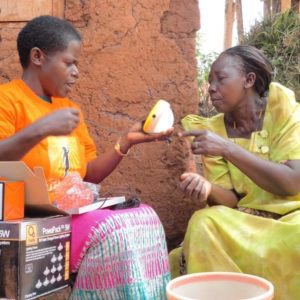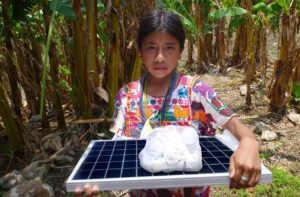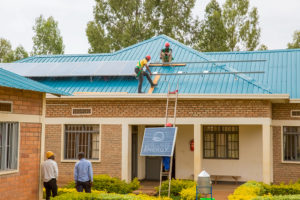
Search
Pay-as-you-go (PAYG) solar systems are getting a lot of attention when talk turns to how solar energy companies use mobile and remote technology to manage far-flung sales and operations in developing countries. By giving customers the opportunity to buy solar lighting and other solar-powered products with installment payments via mobile money – while using the equipment each day – and allowing operators to turn those products on or off remotely based on payment schedules, PAYG is lauded for making off-grid power more accessible.
There are, however, a number of other ways solar energy companies who manufacture, sell and maintain systems are employing mobile and cloud-based technology to increase sales and manage operations from a distance. Here are three examples.
Solar Sister sells and delivers solar products and clean cookstoves in developing countries through a “local agent” model, which has helped it build a network of 2,500 largely female entrepreneurs who buy the products from Solar Sister and resell them at a profit to BOP consumers in locations like rural outdoor markets or at local savings groups across Uganda, Nigeria and Tanzania.
The social enterprise uses TaroWorks’ offline mobile CRM app for its field staff to log sales and deliveries in the field on their tablets. Logs are synced back to their cloud-hosted Salesforce CRM database, where managers can view aggregated reports to see progress and trends. Having this kind of visibility into the operations and activities allows the company to identify problem areas and therefore improve the productivity of the business development associates who sign up Solar Sister entrepreneurs, sell them products for resale and train them to manage their own small business.
Using mobile and cloud-based technology to direct sales and oversee fulfillment of orders has replaced a prior process of recording sales and issuing receipts on paper by generating sales invoices digitally, all of which are also logged in an online database simultaneously accessible to multiple Solar Sister team members. Paper sales receipts can also be printed out from mobile devices for customers and the work of the business development associates is managed remotely by creating trackable performance goals and task lists – as well as scheduling sales calls. Learn more in this recap of a recent Solar Sister webinar.

Source: Solar Sister
Solar Sister’s Chief Operating Officer David O’Connor wrote that collecting and analyzing such data in real-time has helped his company develop key performance indicators.
“A specific metric that is now one of our main key performance indicators as an organization is to track the level of engagement (based on the frequency of their sales) of our entrepreneurs. We created this metric as a way to encourage our team to focus on the retention of our entrepreneurs because the data was telling us that we had too many entrepreneurs who would purchase a couple times and then leave. As a result of setting up this metric that would only be possible with the use of our (mobile and cloud-based) systems, we have seen increased retention of our entrepreneurs.” (Read More)
Iluméxico is a social enterprise whose mission is to provide access to solar systems for people living without electricity in remote, impoverished areas of Mexico. The company provides all the equipment, local training and financing programs that their customers need to turn on the lights.
Iluméxico uses TaroWorks and Salesforce to track maintenance cases for 6,500 solar systems through 9 major regions (and growing) by logging issues, coordinating different roles to resolve each issue and monitoring reports to prevent systemic problems.
Before adopting mobile technology, Ilumexico – like some other solar energy companies – used pen and paper to collect data, which contributed to a lack of quality error tracking and visibility, average case resolution times of more than two months, a loss of payments on products that weren’t working and a loss of potential customers if they encountered faulty devices.

Solar Panel. Source: Ilumexico
Quality issues for solar energy companies like Ilumexico can include problems with the product’s manufacturing, installation efforts or operation. For Ilumexico, the chain of responsibility for resolving such issues begins with the field officer who reports the issue using their mobile app, the operations director who routes the issue to right party, and the quality and manufacturing teams who resolve the issue. When field staff notice a quality issue on a site visit, they’ll fill out the quality report form to log the type of issue, add additional information about the case and take a photo.
Once they sync with a cloud-hosted database and analytics system, a case record is generated and the operations director is automatically notified by email that a new case has been created. The manufacturing team will make necessary changes, log their solution and close the case. Aggregating all of this information in the cloud allows anyone accessing a customer’s account to see the entire history of the relationship Ilumexico has had with that household.
Iluméxico also created automated online reporting dashboards to track trends from the collected data, allowing them to determine, for example, that many of the initial issues involved panel cables and missing installation materials like screws and nails, insights that led them to change their shipment process to ultimately reduce maintenance tickets. (Read More)
One of Rwanda’s more established solar energy companies, Great Lakes Energy uses wifi-enabled hardware on the ground, web-based analytics and a mobile app to build a “remote monitoring and control” network that measures solar system usage in real-time.
The company offers technology and services targeted to health care providers in Rwanda and is designed to give those solar system owners “…the tools and the data to allow them to clearly understand the relationships between their energy consumption patterns and their energy system performance.” A number of Rwandan health care facilities power lights and equipment with legacy solar systems donated over the years. Giving solar energy companies the ability to quickly assess and manage energy storage capacity from a distance, can extend battery life on well worn solar setups as well as improve performance of new units. To accomplish such tasks, Great Lakes Energy’s remote monitoring and control module “…reports to the central server, which communicates with end users, maintenance teams, ministry officials and funding bodies via web portal, mobile apps and SMS.”

Source: Great Lakes Energy, LTD.
According to Great Lakes Energy, with its “Solar Energy Services for Healthcare” product:
“…healthcare providers receive system performance information on their phones. Lab technicians can receive valuable information such as notices for optimal energy times for running equipment such as an autoclave. The nurse receives a notice that she has left the lights on in the middle of the day. The administrator receives a graph showing energy production and consumption, allowing her to clearly understand her site’s potential for growth of energy demand.” (Read More)
POST TOPICS
PREVIOUS POST
Sign up to receive emails with TaroWorks news, industry trends and best practices.
TaroWorks, a Grameen Foundation company.
Site by V+V